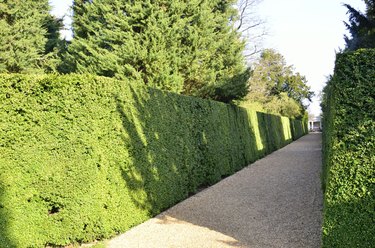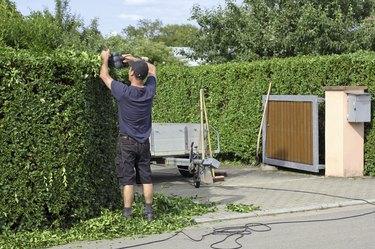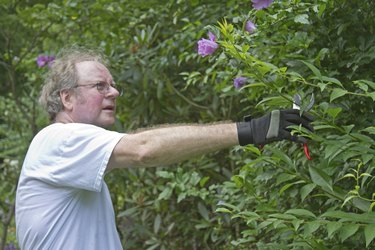
Hedges play many roles in your yard: defining the boundaries of your property, increasing your sense of privacy or sheltering you from wind when you're outdoors. Many types of plants develop into a hedge when planted in a row, spaced close enough to blend with each other. If you want to grow a hedge, you have many different plants from which to choose, depending on your garden situation and your needs.
Evergreen Hedges
Video of the Day

A hedge made of evergreen plants stays green year-round, making it a good choice for privacy or to block winds in all seasons. You can choose tall evergreens, such as the American arborvitae (Thuja occidentalis), a trouble-free, low-maintenance plant covered with flattened, evergreen scales. It grows to 30 feet tall and 5 feet wide in U.S. Department of Agriculture plant hardiness zones 2 through 7. You can grow a leafy evergreen hedge by choosing Korean boxwood (Buxus sinica var. insularis), which is much shorter than the arborvitae, about 2 1/2 feet tall, spreading to about 4 feet. The "Wintergreen" cultivar (Buxus sinica var. insuaris "Wintergreen") grows 4 feet high, and responds well to being trimmed into a formal shape. Both boxwoods grow in USDA zones 4 through 9.
Video of the Day
Deciduous Hedges

A hedge made from deciduous plants can filter wind, even when not in leaf, and usually responds well to pruning. It can also be more forgiving than an evergreen hedge if you miss a year or two of regular pruning and need to do severe pruning in later years. Examples include privet (Ligustrum x ibolium), a fast-growing, shrubby plant that's 8 to 12 feet tall and 6 to 8 feet wide at maturity. It grows in USDA zones 4 through 7, responds well to shearing, and has white flowers in spring that attract butterflies and bees. It is invasive in some areas, so check before planting. Burning bush (Euonymus alatus) is another shrub that grows in USDA zones 4 through 8 and can grow 20 feet tall and 12 feet wide. It's known for the flaming red fall foliage from which it gets its common name.
Flowering Hedges

Some flowering plants can also grow as a hedge when planted in a row. These include the rose of Sharon (Hibiscus syriacus), which blooms in pink to purple in summer and grows in USDA zones 5 through 8. You can shear it yearly for a formal look, or leave it unclipped to develop a flower-covered, natural, 12-foot hedge. Wigela (Weigela florida) is another shrubby plant that can grow into a flowering hedge when multiple plants are grown in a row. A Chinese native, it grows up to 10 feet tall and 12 feet wide in USDA zones 4 through 8 and has rose to pink flowers in spring.
Other Hedge Choices

Certain plants bring special features to a garden hedge -- some have thorns that make them useful as barrier plantings. These include the barberry (Berberis x mentorensis), a low-maintenance plant with sharp thorns. It grows 5 to 7 feet tall, with an equal spread, in USDA zones 5 through 8. You can grow a hedge that has colorful berries that sometimes remain on the plants through winter. Winterberry (Ilex verticillata "Winter Red") is a good example of this type, growing about 8 feet tall and wide in USDA zones 3 through 9. It's a female plant with red berries in fall, so you'll need to plant one or two male plants, such as the "Southern Gentleman" variety of the same species (Ilex verticillata "Southern Gentleman"), which grows in USDA zones 3 through 8.
- Royal Horticultural Society: Hedges -- Selection
- Missouri Botanical Garden: Ligustrum x Ibolium
- Missouri Botanical Garden: Thuja Occidentalis
- Missouri Botanical Garden: Buxus Sinica var. Insularis
- Missouri Botanical Garden: Buxus Sinica var. Insularis "Wintergreen"
- Missouri Botanical Garden: Euonymus Alatus
- Missouri Botanical Garden: Hibiscus Syriacus
- Missouri Botanical Garden: Wigela Florida
- Missouri Botanical Garden: Berberis x Mentorensis
- Missouri Botanical Garden: Ilex Verticillata "Winter Red"